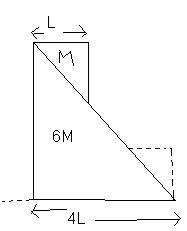please help karo [7][7]

Q) A small wedge of Mass M slides on the bigger wedge initially on the smooth horizontal ground as shown in figure . The mass of the bigger wedge is 6M. When the smaller wedge reaches the base of the bigger wedge , the distance moved by the bigger wedge is
A) L B) 4L/5 C) 2L/3 D) 3L/7
ans ---------- >D
-
UP 0 DOWN 0 0 10

10 Answers
I am getting distance =3l/7 using the principal of conservation of linear momentum between two blocks.
M*3l={M+6M}*l'--------
so l'=3l/7 ???
The force of buoyancy exerted by the atmosphere on a balloon is B in the upward direction and remains constant . The force of air resistance on the balloon acts opposite to the direction of the velocity and is proportional to it. The ballon carries a mass M and is found to fall down near the earth's surface with a constant velocity v. How much mass should be removed from the balloon so that it may rise with a constant velocity v????
see case one[downward motion]
forces are
1.weight Mg down.
2.B upwards
3.air resitance kv[k=some constant]
so Mg=B+kv............(i)
case two[upward motion]
1.weight (M-m)g down
2.air resistance kv dwonwards
3.B upwards
so now,B=(M-m)g+kv
substitute value of kv from equation no. (i)
which gives m=2[M-B/g]
these sum is simple just simply use vector relations n u cn solve it
assumiforce acting in the downwards direction as +ve
therfore
mg-B-kv=0 kv is the air resistance force which acts always opp 2 the direcction of motion
n let the new mass be m1
m1g+kv-B=0
adding both the equations
m1g+mg=2B
g(m1+m)=2b
2b/g=m-mdropped+m
therfore m drobpped
=2(m-B/g)